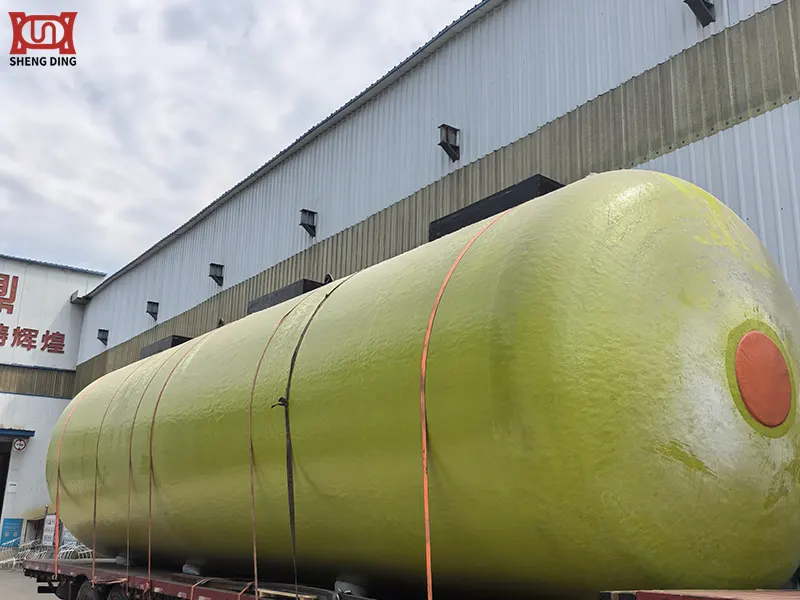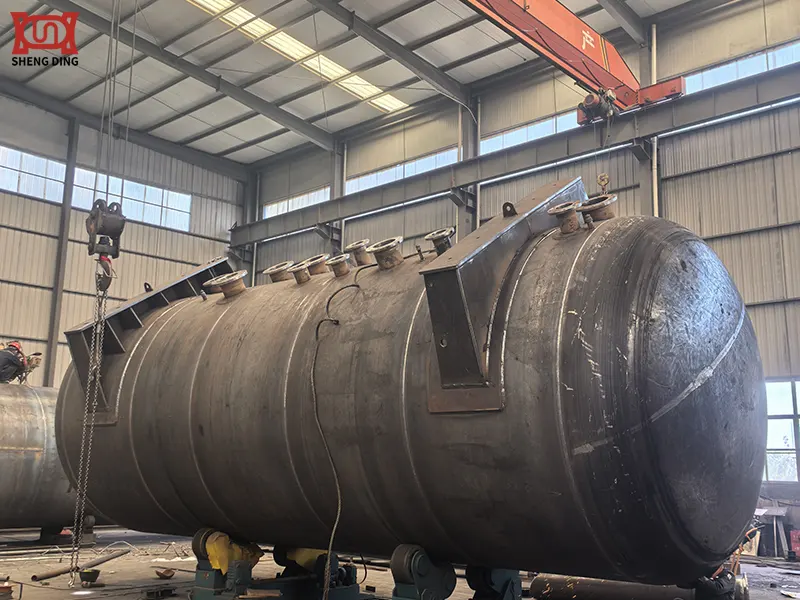Methods and measures to enhance the corrosion resistance of double walled tank
Double walled tank are currently a primary means of storing oil in production. They can be used independently or in conjunction with skid-mounted gas stations, providing businesses and organizations with highly secure fuel access. However, corrosion of the tank body during operation is a key factor affecting its normal operation. Therefore, it is crucial to maximize corrosion resistance during production and installation. Today, we will explain specific measures from multiple perspectives, including material selection, structural design, manufacturing processes, auxiliary protection, and monitoring and maintenance.


1. Source Control: High-Performance Materials and Manufacturing of the Tank Body
The quality of the double-walled oil tank itself is always the most fundamental line of defense against corrosion.
1.1. High-Quality Tank Material:
- High-Strength Fiberglass Reinforced Plastic (FRP) Exterior: Modern double walled tank typically utilize fiberglass reinforced plastic (FRP) for their exterior shells. High-quality FRP with a high resin content, corrosion resistance, and seamless winding should be selected. It offers excellent soil corrosion resistance, electrical insulation, and waterproof properties.
- High-Strength Steel Inner Shell: Inner shell steel should not be made of ordinary carbon steel. Steels with higher corrosion resistance, such as API 5L pipeline steel or micro-alloyed steel, should be selected for their enhanced resistance to sulfide stress corrosion cracking.
1.2. Advanced Anti-Corrosion Coatings:
- Inner Shell Coating: To protect against moisture and corrosive substances that may be present in stored media (such as gasoline and diesel), a high-performance anti-corrosion coating, such as solvent-free epoxy or glass flake coating, is sprayed onto the inner shell. These coatings are dense, highly adhesive, and chemically resistant, effectively isolating corrosive components from the oil.
- External Shell Coating (for Steel Inner Shell): A reinforced epoxy coal tar coating or a three-layer PE (polyethylene) anti-corrosion structure is applied to the outer shell of the steel inner shell. These coatings offer excellent insulation, chemical stability, and mechanical strength, protecting against soil moisture, chemicals, and microorganisms.
1.3. Superior Manufacturing Process and Quality Control:
- Seamless winding/welding technology: Ensures the tank body (especially the inner shell) is seamless and flawless, fundamentally eliminating any starting points for corrosion.
- Strict leak detection system: The vacuum monitoring or liquid sensing/pressure monitoring system within the double-layer gap must be sensitive and reliable. This is not only crucial for leak detection but also for preventing further corrosion. If even a small leak in the inner shell occurs, the system will immediately generate an alarm, preventing the accumulation of corrosive media in the interlayer and thus corroding and perforating the outer shell.
- Factory inspection: Rigorous spark testing is performed to verify coating integrity, and pressure/vacuum testing is performed to ensure structural leaks.
2. Active Protection: Electrochemical Protection (Cathodic Protection)
This is the most effective and commonly used mandatory measure for protecting buried steel inner shells.
2.1. Sacrificial Anode Method:
- Principle: A metal more reactive than steel (such as magnesium alloy or zinc alloy) is installed around the tank body as an anode, connected to the tank body via a wire. In an electrolyte (soil), the anode corrodes preferentially, sacrificing itself to protect the steel tank.
- Applicable Scenarios: Suitable for small sites with low soil resistivity, no ambient stray current interference, and where a particularly long protection life is not required.
- Advantages: No external power supply required, simple installation, and low maintenance.
- Disadvantages: Limited output current, and protection life is limited by the anode material.
2.2. Impressed Current Method:
- Principle: External AC power is converted to DC via a rectifier. The positive electrode is connected to a buried inert auxiliary anode (such as high-silicon cast iron or MMO titanium anode), and the negative electrode is connected to the protected tank. By applying a reverse current, the tank is forced to become the cathode, achieving protection.
- Applicable Scenarios: Suitable for large tank farms, high soil resistivity, or locations requiring long-term protection. Currently, this method is the more mainstream and reliable choice for locations such as gas stations.
- Advantages: High and adjustable output current, wide protection range, and long life.
- Disadvantages: Requires an external power supply, high initial investment, and requires professional design and regular maintenance.
Note: The cathodic protection system must be designed, installed, and debugged by professionals, and its protection potential must be regularly tested to ensure it is within the effective range (typically -0.85V to -1.2V vs. Cu/CuSO4 reference electrode).
3. System Design and Installation: Creating a Good External Environment
3.1. Scientific Tank Design:
- Impermeable Tank: Use reinforced concrete tanks with waterproof lining to prevent external groundwater infiltration.
- Neutral Sand Backfill: Backfill the space between the tank and the tank with clean, neutral, non-corrosive sand or gravel. This provides uniform support, preventing sharp rocks from scratching the anti-corrosion layer, and creates a good drainage and uniform oxygen concentration environment, reducing localized corrosion.
- Drainage System: A drainage system should be installed at the bottom of the tank to promptly remove any rainwater or groundwater that may seep in.
3.2. Operation and Maintenance:
- Regular Tank Cleaning and Dehydration: Regularly remove accumulated water and impurities at the bottom of the tank to reduce sources of corrosion on the inner wall.
- Preventing stray current: Keep away from DC power supply facilities such as tram tracks and subways, or implement drainage measures.
- Regular weld inspection: Conduct ultrasonic thickness measurement and magnetic flux leakage testing every 6-12 months, focusing on welds and tank bottoms, which are prone to corrosion.
- Regular pipeline inspection: Promptly drain accumulated water and moisture from interlayers and passageways to prevent the outer tank from being exposed to a humid environment for a long time.
4. Continuous Monitoring and Intelligent Management
- Dual-layer gap monitoring system: 24-hour uninterrupted monitoring ensures immediate detection of internal or external leaks.
- Cathodic protection system monitoring: Regularly (at least quarterly) have professionals measure the protection potential to ensure effective system operation.
- Regular tank opening inspection: Based on regulatory requirements and usage, conduct regular internal inspections of the tank to visually assess corrosion conditions and coating integrity.
5. Strictly control storage medium quality
- Regularly test the pH and moisture content of the oil to prevent acidic impurities and moisture from causing internal corrosion.
- Filter and purify the oil before tanking to remove mechanical impurities and prevent impurities from scratching the inner protective layer.
6. Emergency Corrosion Repair Measures
- When localized corrosion is discovered, promptly repair it with grinding and rust removal combined with specialized repair paint to prevent further corrosion.
- For severely corroded areas, repair by excavation and replacement of plate materials is performed to ensure the structural integrity of the tank.


7. Conclusion
To maximize the corrosion resistance of double walled tank, a combination of measures is necessary:
| Level | Core Measures | Purpose |
| Tank Body | High-quality fiberglass outer shell + anti-corrosion-coated steel inner shell | Establishing the first physical and chemical barrier |
| Active Protection | Cathodic Protection System (mandatory) | Actively inhibiting corrosion of the steel inner shell through electrochemical means |
| System Environment | Neutral sand backfill + impermeable tank pool | Creating a uniform, stable, and low-corrosion external environment |
| Monitoring and Early Warning | Double-wall interstitial monitoring + cathodic protection potential monitoring | Real-time early warning to prevent corrosion from developing into leaks |
| Maintenance and Management | Regular tank cleaning, inspection, and maintenance | Promptly identifying and addressing potential problems |
Follow international standards (such as EN 12285-1 or EN 14015) The fundamental guarantee for the effective implementation of all these measures is the design, construction, and acceptance of double walled tank in accordance with relevant standards, etc. These comprehensive measures can significantly extend the service life of double walled tank and effectively prevent oil leaks and environmental pollution caused by corrosion.
The above is a detailed introduction to the methods and measures for enhancing the corrosion resistance of double walled tank. We hope this will be helpful for your future use of double walled tank. Tai'an Shengding Metal Container Manufacturing Co., Ltd. specializes in the design and production of skid-mounted gas stations, double walled tank, explosion-proof refueling equipment, and barrier and explosion-proof materials. We have extensive experience in corrosion protection for skid-mounted gas stations and double walled tank. Please feel free to contact us with any related inquiries.
Written by
TAIAN SHENGDING METAL CONTAINER MANUFACTURING CO., LTD.
Editor Wang
WhatsApp:+86 152 5486 3111
Email:shengdingtank@126.com
- WhatsApp
- E-MailE-Mail:shengdingtank@126.com
- WeChatWeChat:15254863111









